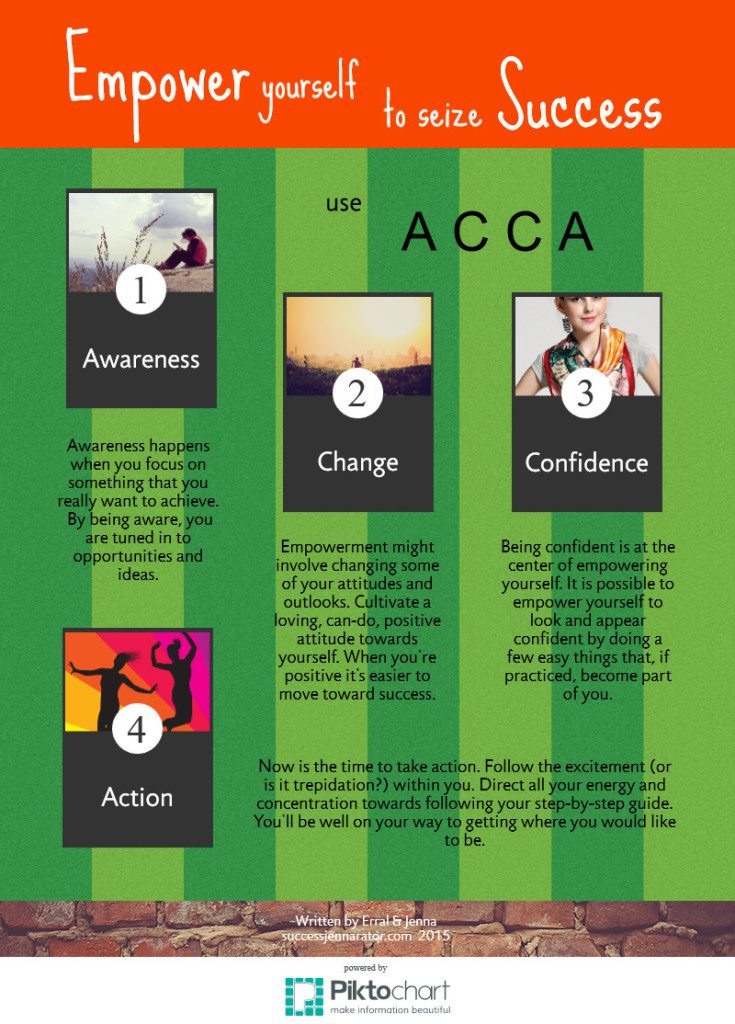Success Advice
4 Strategies To Empower Yourself To Seize Success

Many of us desire to experience success.
Of course success means different things to different people. But for everyone, it’s something that improves their lives.
Stories about how people have achieved success in a variety of areas are commonplace.
They motivate us to search for that elusive key to living a successful, happy and financially independent life.
Maybe the success of others has inspired you to find a more rewarding lifestyle.
Or you might realize your life is blah and that you need to escape from boredom and inaction.
But how can you empower yourself to start on this success journey?
ACCA might be the answer for you.
Grasp these four things and become empowered.
One way to think about empowerment is to consider what disempowerment is. Therefore, I’ll use comparison to explain the four aspects of ACCA.
1. AWARENESS happens when you focus
Disempowering
Not focusing wholeheartedly on what you want to achieve.
Feeling blah, so you’re not aware of opportunities when they arise.
Empowering
Awareness happens when you focus on something you really want. It’s far off but it’s burning brightly.
Because you’re thinking about it a lot, your mind is very aware of it.
To get somewhere you’ve never been before, you have to make a start. Awareness is the place to start.
Listen to people you meet, read news articles and posts on the internet.
Use social media.
Awareness enables you to look around in anticipation.
“Awareness allows us to get outside of our minds and observe it in action.” – Dan Brule
Triggers for ideas pop up in the most unexpected places – on t-shirts, signs, logos, advertisements – wherever. Even bad days or life’s obstacles can be triggers that start your thinking.
Just a tip: Jot things down immediately. Too many good ideas are forgotten through lack of a simple jot.
So, to start the empowerment process, develop awareness.
2. CHANGE is positive – a stepping-stone to success
Disempowering
Telling yourself and believing that you are powerless, and incapable of achieving success.
Empowering
Empowerment might involve changing some of your attitudes and beliefs.
When you catch yourself thinking in terms of “can’t” or “impossible”, tell yourself you can and that it IS possible.
Believe that you are not powerless. You can accomplish anything you strive for. Feel the power within you ready to be unleashed.
In addition to changing beliefs, if you’re dissatisfied with your life, other changes will be unavoidable. Try to see the benefits that change will bring. Then you can embrace it without becoming too overwhelmed.
Remember that the most successful people make changes regularly.
Change is to be desired, not feared. View changing and growing as stepping-stones to success.
Adapting to change is step two towards empowerment.

3. Build up your own CONFIDENCE
Disempowerment
Believing you’ve never felt confident, so you never will in the future.
Empowerment
Recognize that everyone has fears and apprehensions.
It is possible, however, to empower yourself to appear confident by doing a few easy things that, if practiced, become part of you.
- Sit, stand and walk tall with shoulders back.
- Speak slowly and clearly.
- Speak with authority.
- Say a mantra, such as “I speak with confidence and look confident, therefore I AM confident.”
The more you practice, the more confident you’ll become.
Being confident is at the center of empowering yourself.
4. Turn awareness, change and confidence into ACTION
Now that you’ve done lots of discovering, learning and thinking, it’s time to act.
There’s plenty of information freely available about goal setting and planning.
I won’t reinvent the wheel, but would add that recording ONE goal that you’ll work towards, say, six months from now, is essential for success.
To reach that goal, make a list of related jobs for each day of the first week. Repeat this process at the beginning of week two, and so on.
That’s your step-by-step guide.
Follow your guide conscientiously.
“When it is obvious that the goals cannot be reached, don’t adjust the goals, adjust the action steps.” – Confucius
If a little is accomplished each day, week after week, you’ll soon see significant progress on the way to your destination.
Take time out monthly to celebrate the successes you’ve had.
NOW is the time to start taking action.
Empowerment comes from within.
It’s very empowering to choose for yourself what you want in life, and how you’ll work towards it. You discover that empowerment comes from within.
You are in control.
When you believe that you are the only one who can hold you back, wow! That’s empowerment!
The most wonderful thing about empowerment is the end result – you’ll become an extraordinary person because of the growth that has happened along the way, and the hard work you have put into creating a life you are excited about.
What’s next?
Well, that’s up to you.
Remember, your choices will either empower you, or disempower you.
Choose wisely.
Persevere.
The road will be steep. There’ll be obstacles to overcome. Keep your goals before you and imagine the life you want to lead, to keep you always on track.
What are you waiting for?
Have a clear focus. Read, listen, learn. Embrace change. Believe in yourself. Be confident. Take one step every day towards success.
Think BIG and you’ll behave BIG and achieve BIG.
To start the empowering process, I’ve prepared an Infographic based on ACCA for you to download and refer to frequently.

Do you believe that empowerment comes from inside you?
Maybe you’d like to share about your success and what has empowered you.
I invite you to share or leave a comment below.
Change Your Mindset
The Silent Skill That Makes People Respect You Instantly
What truly earns respect and why most people go about it the wrong way

Everybody craves respect but not everyone earns it. Some people believe that a title, years of experience, or a position of authority automatically entitles them to respect. (more…)
Entrepreneurs
The Essential Skills Every Entrepreneur Needs In 2026
Success in the digital age isn’t about luck. It’s about mastering the skills that separate dreamers from doers.

When I was 22 years old, I started my first side hustle as a ghostwriter. (more…)
Did You Know
The Success Patterns You Inherited (And Didn’t Notice)
Your family history may hold the key to why you think, act, and feel the way you do today.

Who are you? Your experiences and your family’s narratives and legacies contribute to your identity. Your ancestry contains individual traits and forces that have been inherited over the years. It also carries the fights and victories of your forebears and older family members. (more…)
Shift Your Mindset
11 E’s That Define Every Great Leader And Why Most People Miss Them
If you’ve ever felt the pull to lead, this is your roadmap to turning inner potential into lasting influence.

What Is Leadership, Really?
Leadership is far more than a title or position. It’s the ability to envision a future, inspire others, and align people toward a shared goal. (more…)
-

 Change Your Mindset4 weeks ago
Change Your Mindset4 weeks agoThe One Leadership Habit That Separates the Great From the Forgettable
-

 Personal Development3 weeks ago
Personal Development3 weeks agoThis Silent Habit Might Be Sabotaging Your Career
-

 Business3 weeks ago
Business3 weeks agoWhy Your E-Commerce Fulfilment Is Probably Broken (And How to Fix It)
-

 Shift Your Mindset2 weeks ago
Shift Your Mindset2 weeks ago11 E’s That Define Every Great Leader And Why Most People Miss Them
-

 Did You Know2 weeks ago
Did You Know2 weeks agoThe Success Patterns You Inherited (And Didn’t Notice)
-

 Business2 weeks ago
Business2 weeks agoThe Hidden Money Pit in Your Operations (and How to Use It)
-

 Entrepreneurs1 week ago
Entrepreneurs1 week agoThe Essential Skills Every Entrepreneur Needs In 2026
-

 Change Your Mindset5 days ago
Change Your Mindset5 days agoHow to Turn Your Mind Into Your Greatest Asset (Instead of Your Enemy)


























8 Comments